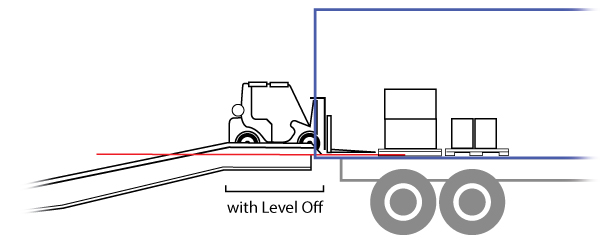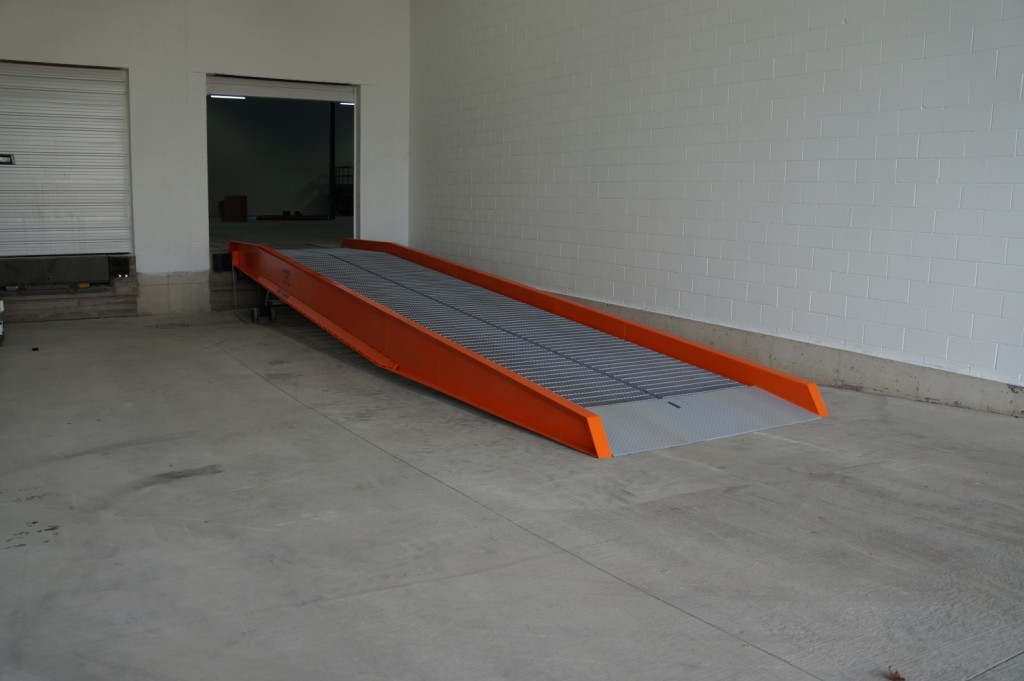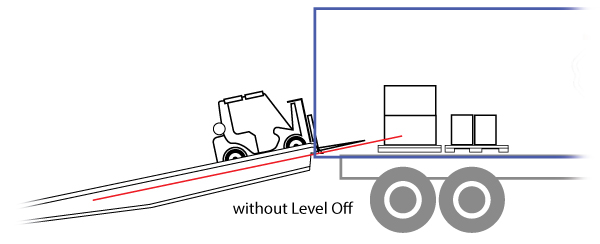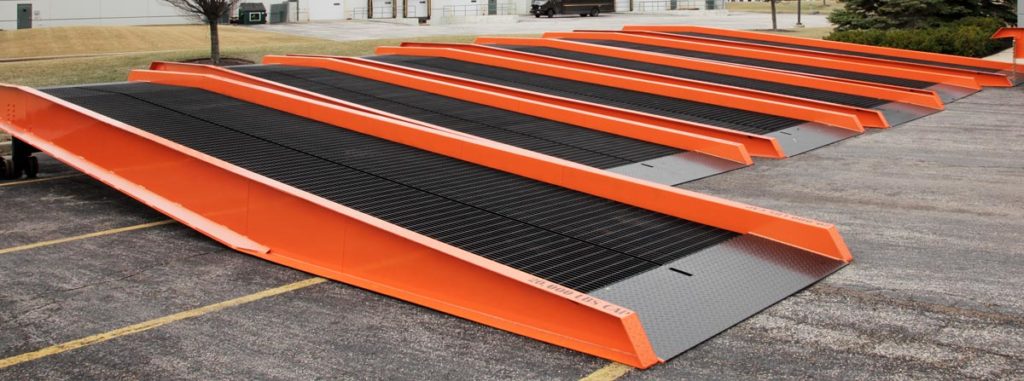If you’re looking to purchase a yard ramp, also known as a portable loading dock, you probably already know that its purpose is to increase the efficiency and safety of your loading operations by creating ground-to-truck and ground-to-dock-access. You may not know, however, which type of yard ramp will work best for your specific application. While similar, yard ramps with level offs and yard ramps without level offs will function slightly differently and have their own benefits and drawbacks. Since yard ramps are used for a variety of purposes such as temporary or permanent loading docks, warehouse expansion, or construction sites, it can be tricky to decide whether your yard ramp should include a level off or not. In this article, we will outline the benefits and drawbacks of level offs on yard ramps to help inform your investment.
Firstly, let’s discuss what a level off is. A level off is a flat platform at the top of the ramp that provides more maneuverability, visibility, and safety for the forklift operator. A level off can make a big difference in the performance and safety of your yard ramp, depending on the type of application and your preferences.
Benefits of Yard Ramps with Level Offs
A yard ramp with a level off is recommended if you are going to use the ramp to unload trucks and trailers from ground level. The level off allows you to level the forks on your forklift so that it can move straight into the rear of the truck or trailer, rather than at an upward angle, enabling access to those pallets located at the very back of the trailer by the doors.

A yard ramp with a level off also provides more stability and control for the forklift operator, as it reduces the risk of tipping over or losing balance on the ramp. A level off also gives the operator more time and space to adjust the speed and direction of the forklift before entering or exiting the trailer. This is especially convenient when forklifts are turning into trailers or have to handle pallets near door openings.
Generally, a yard ramp with a level off is more versatile than a yard ramp without a level off, as it has a wider range of use when it comes to loading and unloading. The level off allows the forklift to load and unload cargo located anywhere in the trailer and can also be used for ground-to-dock access as well.
Drawbacks of Yard Ramps with Level Offs
One drawback of yard ramps with level offs is that they are usually more expensive than yard ramps without level offs. A level off adds more material and labor costs to the manufacturing process, which translates into a higher price tag for the customer. A yard ramp with a level off is also heavier and longer than a yard ramp without a level off, which means it requires more space for storage and transportation. However, if you know you will be unloading cargo from trailers or railcars from ground level, a yard ramp with a level off is a wise investment.
YARD RAMPS WITHOUT LEVEL OFFS
Benefits of Yard Ramps without Level Offs
A yard ramp without a level off is usually shorter and cheaper than a yard ramp with a level off. It is ideal for applications at warehouse loading docks where there’s plenty of space for a forklift to maneuver. Yard ramps with level offs are also useful where space and budget are limited.
A yard ramp without a level off can still provide adequate access and functionality for loading and unloading containers or flatbed trucks from ground level, with the exceptions previously noted. A yard ramp without a level off can also be used to convert a loading dock into a drive-in door. This can be useful when you need to accommodate vehicles that cannot fit your existing dock height. In addition, when placed against the dock edge the yard ramp creates an inclined surface that allows vehicles to drive in and out of your warehouse. This can be especially useful if pickup trucks and vans need frequent access to the warehouse floor for loading and unloading.

Drawbacks of Yard Ramps without Level Offs
The main drawback of yard ramps without level offs is that they are not suitable or safe for unloading semi-trailers or accessing railcars from ground level. Without a level off, the forklift operator has to enter and exit the vehicle at an upward angle, which limits their visibility and maneuverability. This can increase the risk of accidents, injuries, or damage to goods or equipment. Because of this, they are not as versatile as yard ramps with level offs.

Which is Best for Your Needs: A Yard Ramp With or Without a Level Off?
As we’ve discussed above, there are pros and cons to both yard ramps with and without level offs. The best option for you will depend on your specific needs, preferences, and budget. Here are some questions to consider before purchasing your yard ramp:- What type of vehicles are you going to load or unload from ground level? Semitrailers, railcars, containers, flatbed trucks, or others?
- How much space do you have available for storing and transporting the yard ramp?
- What is your budget for your yard ramp purchase?
- Ideal for loading and unloading trailers, flatbed trucks, containers, railcars, and more.
- Ideal for creating ground-to-dock and ground-to-truck access
- More expensive than yard ramps without a level off
- Usually bigger than yard ramps without a level off
- Not ideal for loading and unloading semi-trailers or railcars from the ground
- Ideal for use with flatbed trucks and docks
- Less expensive than yard ramps with a level off
- Usually smaller than yard ramps with a level off
Based on your answers, you can narrow down whether a yard ramp with or without a level off will best fit your needs. The Industrial Toolz team of ramp experts are also at your disposal for consultation and guidance during the buying process. We can help you find the best yard ramp for your application and provide you with our exceptional service and support. Contact us today!
